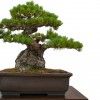 Japanese Black Pine trees are known for their overall ability to survive barren conditions. The oldest known bonsai tree in the world is a Japanese Black Pine. These trees are perfect beginner bonsai because they can survive vacations and any other time the user may forget to water the tree. They grow dark green, small, and dense foliage supported by attractive branches and trunks. The bark begins to become fissured with age, adding to its beauty.
Japanese Black Pine trees are known for their overall ability to survive barren conditions. The oldest known bonsai tree in the world is a Japanese Black Pine. These trees are perfect beginner bonsai because they can survive vacations and any other time the user may forget to water the tree. They grow dark green, small, and dense foliage supported by attractive branches and trunks. The bark begins to become fissured with age, adding to its beauty.
Watering Japanese Black Pine Bonsai
Your Japanese Black Pine tree is extremely drought tolerant. This means that they can go without watering for a small amount of time, perfect for travelers. Water often in the summer to help combat the heat. Misting may be necessary during summer months to protect the foliage from overheating.
Placement of your Japanese Black Pine Bonsai
Position your tree outdoors in full sun, where it will get good air circulation. It is best to rotate your tree occasionally to ensure all sides get even sunlight. Ignoring this could leave you with an unbalanced tree.
Training Japanese Black Pine Bonsai
Balancing the foliage of a Japanese Black Pine tree is an art form all its own. You will need to prune the tree in early spring. This will cause new buds to grow throughout spring. At the end of spring, pinch back those buds, forcing the tree to grow multiple buds in that same location. Then pinch back the healthy ones in areas that are already strong. In areas that are week, pinch back the weak buds so they will become stronger. It takes some practice to balance a Japanese Black Pine tree perfectly, but we haven’t ever had one come out ugly.
Repotting Japanese Black Pine Bonsai
Repot this species in spring right before the buds begin to open. This will allow the roots to grow with the new foliage. Japanese Black Pine are typically planted in a larger pot to help retain extra moisture for the roots. The soil used needs to be well-draining but also have water retention.
Fertilizing Japanese Black Pine Bonsai
Fertilize this tree with an acid-based fertilizer monthly during the growing season. This fertilizer will replace the much needed nutrients in the soil that are washed away from watering.
 |
 |
 |